Machine Learning Skills Roadmap: What You Need to Know
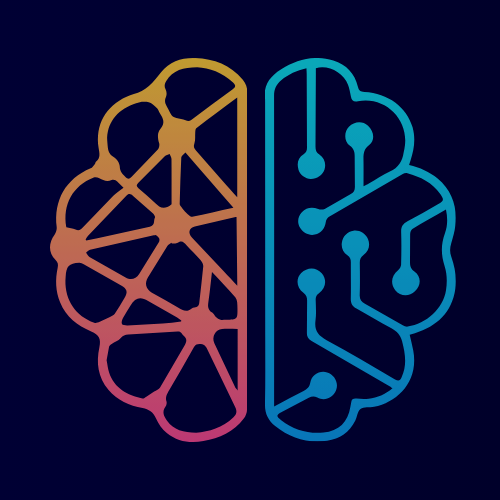 neurontist
neurontist
In the world of changing technologies, adapting to change is crucial. One such area is Artificial Intelligence, or simply AI. This field is changing the way we use to work and build solutions. So learning and getting started becomes a real deal.
As per expert's opinion, "AI won't replace humans, but people who can use it will"
Determining the right goal or path to enter this dynamic field and build a successful career can be challenging. There are plenty of resources to help you get started, but choosing the right one for you makes it difficult to enter and remain consistent.
This blog provides a roadmap to give you an idea of how you can get started, which steps you can follow and how you can define your path to build a successful career.
Let's get started !!
Understanding the AI Universe
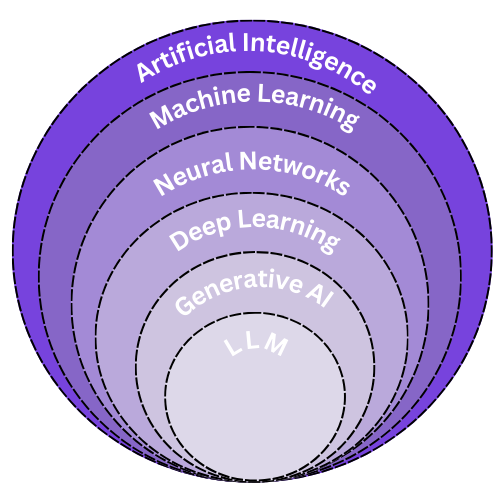
In the above visualization, we can see that learning and understanding AI is very deep. It's important to realize that you don't need to know every concept to become proficient in this field. That's why we should get a basic understanding of each of these sub-domains. This way, you can see which one interests you the most and define your path towards it.
Machine Learning
It is an application of AI in which machines are trained to learn from data and past experiences automatically and derive patterns to make predictions with the least human intervention. It allows machines to learn and improve without being explicitly programmed.
Neural Networks
A neural network is a machine learning program, or model, that makes decisions like the human brain, by using processes that mimic the way biological neurons work together to identify phenomena, weigh options and arrive at conclusions. It is a subset of machine learning.
Deep Learning
Deep learning is a subset of machine learning that uses multilayered neural networks called deep neural networks, to simulate the complex decision-making power of the human brain.
In a simple neural network, every node in one layer is connected to every node in the next layer. There is only a single hidden layer. In contrast, deep learning systems have several hidden layers that make them deep.
Generative AI
Generative AI models can take inputs such as text, image, audio, video, and code and generate new content into any of the modalities mentioned.
Note that traditional AI was limited to data processing, analyzing and performing specific tasks but Generative AI generates new content based on the feed.
LLM
Large language models (LLM) are very large deep learning models that are pre-trained on vast amounts of data. Large language models use transformer models and are trained using massive datasets — hence, large.
As AI is evolving, no one knows what will be the next to enter this era of AI.
Now that we have a basic understanding of these sub-domains, let's talk about how to get started, specifically Machine Learning.
Machine learning: Roadmap
Machine learning (ML) is the first and fundamental step in understanding artificial intelligence. This blog will give you a complete guide to becoming confident in starting projects in ML.
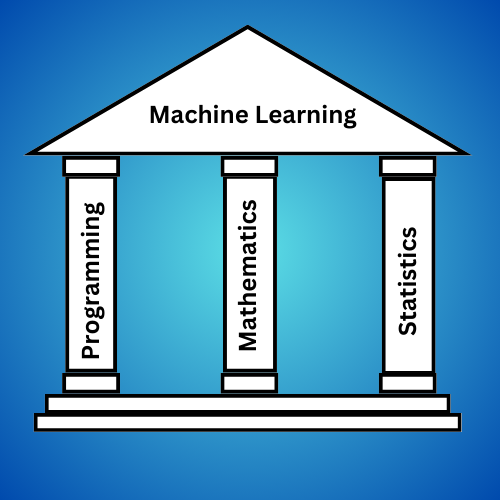
As you can see, in order to get started with machine learning, three fundamental skills are required. Our roadmap will be based on these three pillars.
Step 1: Learn Python
Learning Python is a good way to start your journey as it will provide a base to build machine learning models and algorithms. The popularity of Python is because of its**readability, extensive libraries and frameworks, strong community support, compatibility with other languages and scalability*.*
This programming language is also easy to learn and someone with no programming background can also easily pick it up. I would recommend going with Python rather than the next popular language Julia.
Now the question arises how much Python is needed for machine learning?
Basic Python would be enough to get going. There are some fantastic courses out there that would be enough.
Resources:
100 Days of Code: The Complete Python Pro Bootcamp
Python for Everybody Specialization
Python Full Course For Beginners
The one course I would recommend is 100 Days of Code by Angela Yu. It's a 100-day series that will provide a core understanding of Python.
If you are still not confident then it's time for some Python projects. Here is the resource that I suggest.
Resource: Python Projects
Step 2: Python libraries and Mathematics
The reason for recommending both things simultaneously is to learn and then implement them immediately. Mathematics is a subject that makes many people lack interest with time. But there's good news! You don't need to have very depth of mathematics.
Knowing the below concepts will be enough to keep you going.
Mathematics and Statistics:
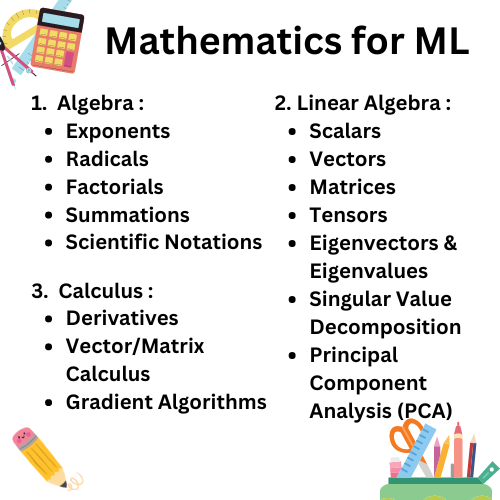
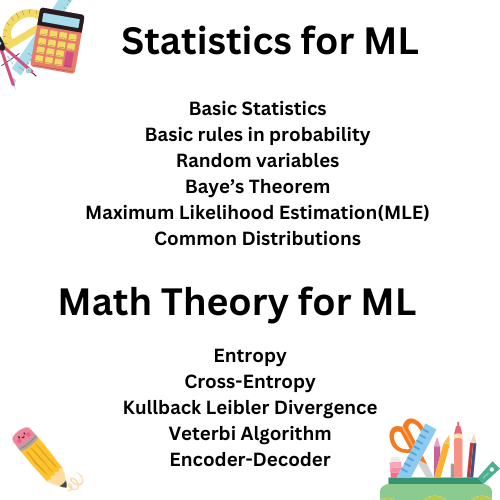
These concepts are important at the time of building models and deriving logic. Below are the resources that will help you understand these concepts and build a solid foundation.
Resources:
Remember one thing, picking one concept and going into depth is not recommended unless needed. This is because the more you start going into depths the more you will be exhausted. Always remember: Learn while you build!
Now that we know how much to learn, let's see the libraries that we can learn to apply our mathematics knowledge.
Libraries :

These are the three libraries you must learn to excel in data analytics which is needed for ML. Start with pandas and NumPy first.
NumPy excels in creating N-dimension data objects and performing mathematical operations efficiently, while Pandas is renowned for data wrangling and its ability to handle large datasets. When you are done with both move on to matplotlib a renowned Python library.
Matplotlib is a popular data visualization library in Python used for**creating high-quality charts and plots. It provides a wide range of functionalities to visualize data in various formats, making it an essential tool for data analysis and exploration.
Resources:
At this stage, we are ready to with the next step: learn some Python frameworks.
Step 3: Python frameworks
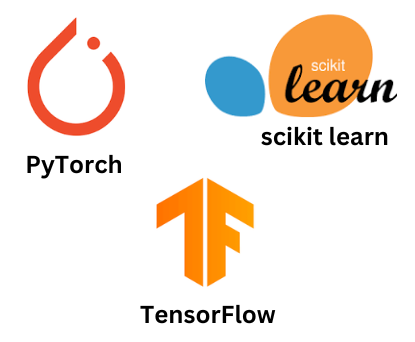
There are many frameworks, but choosing the most suitable one is important. For beginners, learning PyTorch and Scikit learn is easy. These two frameworks will help you understand the mechanisms behind the scenes and will be powerful tools throughout your career. Once you are confident with PyTorch going with TensorFlow will not be difficult. I would suggest choosing one framework and mastering it.
Let's start with what we've been waiting for : learning ML and building projects.
Step 4: Learning ML and Building Projects
Learning ML for the first time can be fascinating but also challenging. Strengthening your fundamentals in ML is crucial for your journey. The moment you start understanding these concepts is when you'll move towards a successful career.
Now the question arises: which resource should I start with?
Don't worry here is the resource :
Machine Learning Specialization
This course is a great way to learn the fundamental concepts of ML. But don't restrict yourself with the course, do research for more to keep immersed in learning. After gaining knowledge of ML, let's start implementing it.
A great place to start creating projects is Kaggle. A subsidiary of Google, it is an online community of data scientists and machine learning engineers. Kaggle allows users to find datasets they want to use in building AI models, publish datasets, work with other data scientists and machine learning engineers, and enter competitions to solve data science and ML challenges.
If you are unsure where to start, Kaggle offers a very interesting project:
Titanic - Machine learning from Disaster. You can start here.
Link: Titanic - ML from Disaster
Continue building and growing your skills. If you think this is all, let's explore the next step to enhance your portfolio.
Step 5: Getting Certified in the Cloud
Getting certified is a great way to showcase the skills you've learned so far and to stand out from the crowd. Cloud is a good start as all infrastructure is moving to cloud in recent decades. There are various service providers but two major are: Amazon AWS and Azure Microsoft. Here, we will focus on those related to AI/ML.
Amazon AWS
Step 1 - AWS Certified AI Practitioner (Amazon is recently launching which will give you a start on applying your ML knowledge to the cloud.)
Step 2 - AWS Certified Machine Learning Engineer - Associate
Microsoft Azure
Step 1 - Microsoft Certified AI Fundamentals
Step 2- Microsoft Certified AI Engineer - Associate
Link: Microsoft Azure
Choose the certification that suits you best and get started. Both Cloud and ML will boost your career and help you land your dream job.
This roadmap and the steps discussed are based on research and current trends. You can define your path and follow it.
Disclaimer: The resources in this blog are taken from trusted providers like IBM, Amazon, Microsoft, etc to ensure a good learning experience.
That's it for this blog. I hope it provides you the way to your dream career. If you want to learn about other career paths, please leave a comment.
Do share the blog so that others can benefit too
Keep Learning and Keep Exploring !!
Subscribe to my newsletter
Read articles from neurontist directly inside your inbox. Subscribe to the newsletter, and don't miss out.
Written by

neurontist
neurontist
A Developer Preparing for a Machine Learning Career. With a foundation in development, I am now immersed in AI. Mastering innovative tools and acquiring certifications; a quest for knowledge, growth, and impact.